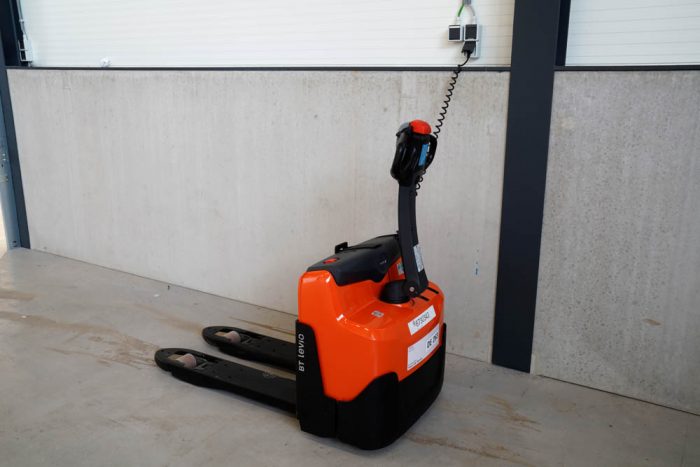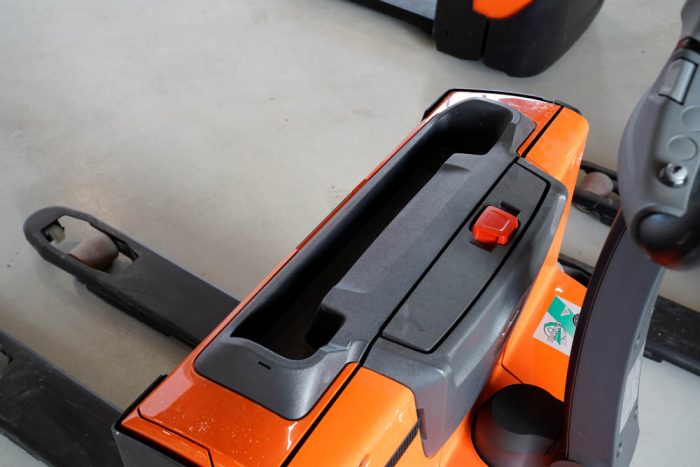With the BT Levio LWE series, Toyota Material Handling offers a range of powerful powered pallet trucks. The Levio LWI 160 has recently been added to the range. Built around an integrated lithium-ion battery, this truck is more compact and more energy efficient, as our test shows.

Toyota Material Handling’s mission was clear: design a pallet truck based on the question ‘How do we get rid of the standard battery compartment?’. The goal was to develop a lighter, smart-charging electric pallet truck that was more energy efficient, more manoeuvrable, and more compact, yet still powerful.
With the development of the BT Levio LWI 160, that goal has been achieved. The modularity of the lithium-ion batteries opened the door to a completely different design. We look at this truck and compare it to the BT Levio LWE 160 in two versions – one with a conventional lead-acid battery and one with a lithium-ion battery.
We put the three trucks together and immediately notice that the Levio LWI 160 looks more compact and slimmer than both LWE 160s. It’s hard to believe that these trucks would perform equally. The LWI is lower and has a shorter l2 dimension, but it still has the same power for driving and lifting.
Also identical is the drawbar. Toyota Material Handling has been using the same well-proven tiller on its trucks for many years. The buttons for lifting and lowering are logically organised and easy to operate with both left and right hands. Lifting and lowering itself is somewhat abrupt. It is on or off, but according to Toyota that is a matter of adjustment.
The horn and the emergency stop are well placed and function correctly. The small central display shows the battery status and any possible operating codes or faults. For example, the display shows whether Click2Creep is active. By repeatedly operating the butterfly before driving, the truck activates this function. This allows you to manoeuvre with the tiller in the upright position, which is especially useful when space is tight. On the lower side of the tiller head you find the keys of the PIN code lock.
It is a pity that the LWI in our test does not offer any storage options for, say, a pen, pencil, or phone. There is a USB connection on the truck, but regardless of what you want to do with it, where do you leave the device that is on the other side of the cable?
With the tiller in hand and at the correct working distance, it is noticeable that the Levio LWI 160 offers a better view of the fork tips. The chassis of this LWI with 50 Ah/24V integrated li-ion battery is considerably lower than the battery compartment of the LWE. We measure the free visibility to the fork: 470 mm for the LWI against 285 mm for the LWE with a comparable fork length of 995 mm. The extra visibility makes manoeuvring just that little bit easier for every pallet pick-up.
When picking up loads, we also measure some differences. The LWI lifts a little higher than both LWEs, so the whole lifting and lowering process takes a little longer. With the LWE trucks, we see a phenomenon that we see with almost all truck brands where it is possible to install lead-acid or lithium-ion batteries in the same truck: the lithium-ion version is always slightly faster and more powerful. This is partly due to the higher operating voltage, which is not around 24V but well over 25V.
We notice the effect of the difference in battery type when driving. The li-ion trucks move more smoothly than the truck with the lead-acid battery. This is especially noticeable with heavy loads on the fork. The question is, of course, does this translate into productivity? The answer is no. Both LWE trucks score the same values in pallets per hour. The compact LWI is a tad slower, but that’ s not because of its size or individual performance. The difference is purely the result of the automatic speed reduction when cornering. This function is only activated on the LWI. It is a safety option that is also available on both other trucks.
This automatic speed reduction is not a luxury when operating the truck at maximum power. With a travel speed of over 6 kph, all three Levios are actually a little too fast for comfortable operation. In tight curves, the truck pushes you a bit. When it comes to productivity, all Levio trucks score in line with the market or even better.
And then there is energy consumption. Not really a heavy topic with trucks like this, but still. Every extra kWh counts. We measure differences between the two LWE trucks as well as between the LWE and LWI. The LWE with the lead-acid battery consumes 18% more energy than its brother with li-ion battery. The LWI with integrated li-ion battery is, in turn, 10% more energy efficient than the LWE with li-ion battery. This is because the LWI only lifts the fork. Furthermore, the LWI weighs 274 kg, which makes it 54 kg lighter than the LWE with li-ion battery and 145 kg lighter than the truck with lead-acid battery.
Of course, when it comes to operating times, there are differences too. The Levio LWI 160 in our test has ‘just’ 50 Ah on board, which gives it a practical operating time of 4.5 hours. The other two trucks, with their respectively 105 Ah (li-ion) and 150 Ah (lead-acid) batteries, manage to more than double this. Is this a problem for the LWI?
No. Thanks to the built-in 230V charger, you can easily plug it into any standard socket. The li-ion technology allows for trouble-free intermediate charging. By charging in between, for example during a quarter or half an hour break, you can keep the truck operational all day long. Moreover, li-ion batteries are completely maintenance-free. And that really makes a difference. By the way: both other trucks also have a built-in 230V charger. In terms of energy consumption, the li-ion trucks score better than the average in their class. However, that average mainly includes trucks with lead-acid batteries.
With the introduction of the BT Levio LWI 160, Toyota Material Handling brings a serious and powerful alternative to its successful LWE range. The truck is more compact, lighter, more energy efficient and yet still as powerful as its much larger counterparts. It is ideal for use in tighter working environments or to carry along on the lorry. The newcomer is just as robust as its bigger brothers and, despite its more compact size, retains its typical industrial character.
Whoever chooses the Levio LWI 160 in its most compact size, i.e., with a 50 Ah battery, also chooses another way of using and recharging it. With this newcomer you will have a powerful, low-maintenance and always available all-rounder.
• Maintenance-free li-ion technology
• Performance levels
• Compact size and weight
• Lifting/lowering dosage
• Driving speeds a tad too high
• Storage space on the LWI
























(Text and photos: Andersom Testing, Theo Egberts)
Tags:
Andersom test, Andersom testing, BT Levio, BT Levio LWE160, BT Levio LWI160, Pallet truck, Pallet trucks, Toyota, Toyota BT Levio LWE160, Toyota BT Levio LWI160, Toyota Material Handling
Small truck, big actions With the recent tests of the ...

IC Killer With the new RX60 Still brings a first in...

Jungheinrich has renewed its ride along pallet truck ER...